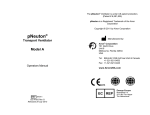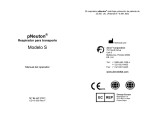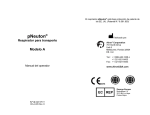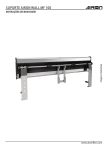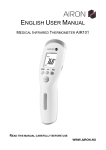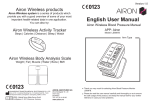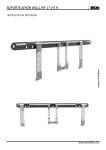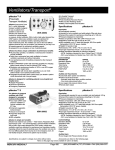Download MACS ® Mask CPAP System
Transcript
MACS® Mask CPAP System Operators Manual 20101 CD–M–005 Rev E Released 23 March 2015 The MACS CPAP delivery system is under US patent protection as part of the pNeuton® Ventilator (Patent # 6,591,835) pNeuton and MACS are Registered Trademarks of the Airon Corporation Copyright © 2014 by Airon Corporation Manufactured by: Airon® Corporation 751 North Drive Unit 6 Melbourne, Florida 32934 USA Tel: 888-448-1238 (toll free USA & Canada) +1-321-821-9433 Fax: +1-321-821-9443 www.AironUSA.com Emergo Europe EC REP Molenstraat 15 2513 BH The Hague The Netherlands Table of Contents Section 1. General Description ............................ 1-1 Indications for Use .......................................... 1-1 Contraindications ............................................ 1-2 Section 2. Warnings, Cautions, Notes ................. Warnings ......................................................... Cautions .......................................................... Notes .............................................................. Medical Symbol Key …………………………… 2-1 2-1 2-3 2-3 2-5 Section 3. Controls and Patient Safety Systems .. Front Panel ...................................................... Rear Panel ....................................................... Internal Patient Safety Systems ....................... 3-1 3-1 3-3 3-4 Section 4. Operating Instructions ......................... 4-1 Device Set-up .............................................. 4-1 Operational Verification .................................... 4-1 Patient Set-up…….............................................. 4-3 Oxygen Control ............................................... 4-3 Hypobaric Operation ......................................... 4-3 Section 5. Patient Circuit ...................................... Adult / Pediatric Circuit .................................... Patient Connection ...................................…... Single-Use Medical Devices/Accessories …… 5-1 5-1 5-2 5-3 Section 6. Accessories ……………………………. 6-1 Section 7. Theory of Operation ............................. Pneumatic System Diagram ............................ Pneumatic System Description ......................... CPAP Demand Flow Breathing System ........... Oxygen Delivery System .................................. MACS CPAP System 7-1 7-1 7-2 7-2 7-3 I Section 8. Troubleshooting ……………………….. 8-1 Section 9. Cleaning and Maintenance ................. Cleaning the Device ..................................….. Cleaning / Disinfecting the Patient Circuit ....... Routine Maintenance ...................................... Factory Preventative Maintenance.................... 9-1 9-1 9-1 9-1 9-1 Section 10. Specifications ..................................... 10-1 General Description ......................................…. 10-1 System Performance ........……………..........…. 10-1 Environmental and Physical Characteristics .... 10-2 Power Sources ................................................. 10-2 Section 11. Limited Warranty ................................. 11-1 Section 12. Index ................................................... 12-1 MACS CPAP System II MACS Mask CPAP System Section 1: General Description MACS is a small, lightweight Continuous Positive Airway Pressure (CPAP) system designed for use on spontaneously breathing patients who require oxygen assistance. The patient is allowed to breath spontaneously with minimal work of breathing. The CPAP system provides expiratory positive pressure delivered non-invasively via face mask or invasively via ET tube. The delivered oxygen is adjustable between 65 and 100 percent, with oxygen as the driving source gas. MACS is an all pneumatic device. Electrical power is not required for operation. MACS has been specifically designed for patient support by trained Emergency Medical Professionals, Respiratory Therapists, nurses and physicians, both in the prehospital and hospital environment. It may also be used at the accident scene, during intra and inter-hospital transport, in aircraft, on ambulances, and in emergency rooms. Indications for Use The MACS CPAP System is intended for spontaneously breathing patients requiring up to 140 L/min oxygen at 65% or 100% concentrations. The device is suitable for use in: Pre-hospital transport applications including accident scene, emergency rescue vehicles • Hospital ICU transport applications including emergency, surgery, post-anesthesia / recovery • Air transport via helicopter or fixed wing • MACS CPAP System 1-1 Contraindications The following conditions contraindicate the use of the MACS CPAP System: • Patients undergoing procedures with flammable anesthetic gasses • Patients requiring ventilatory support with mechanical respiratory rate and tidal volume MACS CPAP System 1-2 Section 2: Warnings, Cautions, Notes The MACS Mask CPAP System is intended for use by properly trained personnel under the direct supervision of a licensed medical Physician or Practitioner only. Personnel must become thoroughly familiar with this Operators Manual prior to using the MACS Mask CPAP System on a patient. As used in this manual, the following terms mean: Warning: Indicates the possibility for injury to the patient or the operator Caution: Indicates the possibility of damage to the device Note: Places emphasis on an operating characteristic Warnings This manual serves as a reference. The instructions in this manual are not intended to supercede the physician’s instructions regarding the use of the MACS Mask CPAP System. The operator should read and understand this entire manual before using the MACS system. Incorrect operation can be hazardous. DO NOT use the MACS system in conjunction with flammable anesthetics or in the presence of open flame. Ensure the device and all accessories are free from oil or grease. MACS uses air entrained from the atmosphere. Do not use in contaminated (hazardous, explosive) atmospheres. Only compressed oxygen may be used. MACS CPAP System 2-1 DO NOT use conductive (anti-static) patient breathing circuits. The only approved patient circuit for use with MACS CPAP are the Airon® circuits listed in Section 5 of this manual. Any other patient circuit should NOT be used and may lead to patient harm. The patient and equipment should be constantly monitored. The Airon patient circuit is a single use, disposable device. Cleaning, reprocessing and / or reuse of this device is not recommended. Reprocessing may cause a change in ventilation characteristics. The circuit and all components are sold clean and non-sterile. The Operational Verification tests as described in this manual (Section 4) must be performed prior to connecting a patient to the device. If the device fails any of the tests it must be removed from clinical use. DO NOT return the unit to clinical use until all repairs has been completed by an Airon approved repair facility and all operational verification tests are acceptable. The MACS CPAP System does not have a patient disconnect alarm. If the patient becomes disconnected from the device there will be no audible or visual alarm to indicate this condition. Always observe the patient while providing CPAP support. MACS CPAP System 2-2 Cautions Insure that clean, dry medical grade compressed air is used at all times. Compressed air that is contaminated with water or other material will damage the internal components of the ventilator. DO NOT attempt to service the unit. Service may only be performed by Airon® Corporation authorized engineers. The Preventative Maintenance program requires a general service and calibration every two years. Only original manufacturer parts and accessories should be used, and only factory trained personnel may perform Preventative Maintenance. Any attempts to modify the hardware of this device without the express written approval of Airon Corporation will void all warranties and liabilities. Do not immerse the MACS CPAP System or allow any liquid to enter the case or the inlet filter. Clean as directed in Section 9, Cleaning and Maintenance. Notes In the USA, the MACS CPAP system is a restricted medical device intended for use by qualified medical personnel under the direction of a physician. The CPAP system will operate normally at altitudes up to 15,000 feet. Changes in altitude will not affect pressure provided to the patient. MACS CPAP System 2-3 Special note on the presence of latex: The components, devices, accessories, and packaging that make up the MACS CPAP System do not contain any dry natural rubber or natural rubber latex, which may cause allergic reactions. Special note on the presence of di (2-ethylhexyl) phthalate (DEHP): The components, devices, accessories, and packaging that make up the MACS CPAP System do not contain any phthalates which are classified as carcinogenic, mutagenic or toxic to reproduction, of category 1 or 2, in accordance with Annex I to Directive 67/548/EEC. Additional Warnings, Cautions, and Notes are located throughout this manual. MACS CPAP System 2-4 Airon’s Medical Symbol Key Consult Instructions of Use CE Marked Authorized Representative in European Community Model (Part) Number Lot Number Do Not Reuse MRI Conditional (3 T) Manufacturer Manufactured Date Use By Date Keep Dry Temperature limitation - upper and lower temperature limits MACS CPAP System 2-5 MACS CPAP System 2-6 Section 3: Controls and Patient Safety Systems Front Panel Pressure gauge, patient circuit pressure CPAP control, calibrated, range 0 to 20 cm H2O MACS CPAP System 3-1 Oxygen control, select either 100% or 65% Patient Circuit connection, see section 5 for a complete description of the patient circuit and its attachment to the front panel Expiratory Valve connection MACS CPAP System 3-2 Rear Panel Driving Gas Input (oxygen), DISS connection, requires 55 + 15 psi (380 + 100 kPa), (40 liter/minute minimum) Ambient Air Inlet filter MACS CPAP System 3-3 Internal Patient Safety Systems The MACS CPAP System has the following internal safety systems. These systems help ensure patient safety in the event of device malfunction. High Pressure Release There is an internal safety pressure release valve included in the MACS CPAP System. This valve will automatically limit circuit pressure to approximately 42 cm H2O. Anti-Suffocation System An internal safety system will allow the patient to breathe on his or her own in the event of device malfunction. At approximately 2 cm H2O negative pressure an internal valve will open allowing unimpeded ambient air to enter the patient circuit for the patient. This system is always available to the patient, irrespective of control settings. Note: Always use an external oxygen monitor to ensure the desired oxygen percentage is delivered to the patient. MACS CPAP System 3-4 Section 4: Operating Instructions Device Set-up The following equipment is needed: 1. MACS CPAP Device with breathing circuit (See Section 5) 2. High pressure oxygen hose with pressure regulated oxygen supply 3. Test lung, (1 Liter rigid wall, Airon Part #21002) When ready: 1. Attach breathing circuit to device following instructions in the Operators Manual. 2. Attach the test lung to the patient side of the breathing circuit. 3. With the device set up as described above, adjust the controls as follows: a. Oxygen % to 65% b. CPAP to 10 cm H2O. 4. Attach Oxygen Input (Driving Gas) on rear panel of the device to a high pressure oxygen source and turn on the oxygen. NOTE: The unit will begin operation at the above settings when the oxygen is turned on. Operational Verification Verification Step Expand the test lung at a rate of approximately 10 breaths per minute to simulate spontaneous breathing. Ensure that the pressure gauge returns to 10 ± 2 cm H2O after each breath. MACS CPAP System Acceptable Range 10 ± 2 cm H2O Result Pass / Fail 4-1 Switch the oxygen toggle to 100%. Expand the test lung at a rate of approximately 10 breaths per minute and ensure the pressure gauge returns to 10 ± 2 cm H2O after each breath. Turn the CPAP knob to the off position. Ensure the pressure gauge points inside the off range and flow stops. 10 ± 2 cm H2O Pass / Fail Off Pass / Fail When the device has passed the Operational Verification procedure it is ready for clinical use. If the device fails to pass any of the following tests do not apply it to patients. Call your local distributor or Airon Corporation Customer Support at 888-448-1238. Do not attempt to service the unit. CAUTION: Do not disassemble the MACS CPAP System. No internal user replaceable parts. All service must be performed by Airon Corporation or an approved service technician. Opening the device will negate the warranty. User will be responsible for all repair costs to service the unit. MACS CPAP System 4-2 Patient Set-up 1. Set up the MACS CPAP System according to the set-up instructions above. 2. Attach the patient circuit with face mask to the device. 3. Set the % Oxygen control to the desired FIO2. 4. Adjust the CPAP control to the desired level. There is no adjustment for spontaneous breath trigger sensitivity as this is automatically set by the device. 5. Inform the patient of what you will be doing and apply the face mask. 6. Monitor the pressure gauge to ensure proper delivery of CPAP. Pressure should not vary more than 3 to 4 cm H2O per breath, depending on patient effort. 7. Observe and monitor the patient and the device per your institution's standards. If using a portable oxygen gas supply, monitor the supply level to ensure there is sufficient gas to power the device. Never leave the patient unattended. Oxygen Control The Oxygen control sets the level of oxygen delivered to the patient. The device uses an internal venturi system which provides the 65% oxygen concentration. See Section 7 for a complete description of the Oxygen Delivery System. It is recommended that an external oxygen analyzer always be used to verify oxygen delivery. Hypobaric Operation The device will operate normally at altitudes up to 15,000 feet. Changes in altitude will not affect pressure delivery to the patient. Always monitor the patient carefully using a cardiac monitor. MACS CPAP System 4-3 MACS CPAP System 4-4 Section 5: Patient Circuit Adult / Pediatric Circuit Large adult mask Headstrap The patient circuit designed for use with the MACS CPAP System is part number 58011; 6 ft. disposable patient circuit with disposable face mask (size Large) and headstrap. The compression volume is 1 ml per cm H2O. Additionally, a full range of compatible patient circuits is available to meet your needs. Other patient circuits may become available in the future. All acceptable circuits will have part numbers from 58001 to 58999. Part Number 58001 58006 58011 58021 58051 Description 6 ft. (1.8 m) disposable, box of 15 6 ft. (1.8 m) disposable, with expiratory filter, box of 15 6 ft. (1.8 m) disposable, with large adult mask and head strap, box of 10 6 ft. (1.8 m) disposable, with expiratory filter, large adult mask and head strap, box of 10 8 ft. (2.4 m) disposable, box of 15 WARNING: Patient circuits other than the Airon® circuits listed above may alter the ventilator's CPAP / PEEP characteristics and / or expiratory flow resistance. They should NOT be used and may lead to patient harm. MACS CPAP System 5-1 WARNING: Do not use air filters on the expiratory port of the patient circuit except those provided by Airon Corporation. Some filters may alter the ventilator's CPAP characteristics and / or expiratory flow resistance. They should NOT be used and may lead to patient harm. CAUTION: The MACS requires the use of a nonvented full-face mask for proper CPAP operation. Patient Connection The patient circuit must be attached to MACS properly. Incorrect attachment could result in failure to provide adequate oxygen delivery. The main breathing hose (22mm) is connected to the large connection port. The small tubing (3mm) connects the expiratory valve to the small connection port. NOTE: The Airon patient circuit is a single use, disposable device. Cleaning, reprocessing and / or reuse of this device is not recommended. The circuit and all components are sold clean and non-sterile. MACS CPAP System 5-2 Single-Use only Medical Devices/Accessories How do I know if a device is Single-Use? This symbol will be identified on the packaging and User’s Manual of the device. What does Single-Use mean? Do not reuse. A single-use device is used on an individual patient during a procedure, such as transport ventilation, and then discarded. It is not intended to be reprocessed and used again, even on the same patient. What is the concern with reused device labeled SingleUse? The use of reprocessed devices may present serious incidents relating to the health and safety of patients and healthcare professionals. Reuse can be unsafe because of risk of: • • • • Cross-infection – inability to clean and decontaminate due to design, device components are not manufactured for disassembly and reassembly Endotoxin reaction – excessive bacterial breakdown products, which cannot be adequately removed by cleaning Patient injury – device failure from reprocessing or reuse because of fatigue or material alteration Chemical burns or sensitization – residues from chemical decontamination agents on materials that can absorb chemicals NOTE: If you reuse a single-use device you may be legally liable for the safe performance of the device. MACS CPAP System 5-3 MACS CPAP System 5-4 Section 6: Accessories Using the MACS CPAP System should be convenient and user-friendly for healthcare providers and patients. Accessories for the device add serviceability in clinical situations and allow the device to be adaptable to the environment of use. Adult/pediatric patient circuit - Disposable, single patient use. - 6 foot (1.8m) and 8 foot (2.4m) length Adult/pediatric CPAP Masks Disposable, single patient use. Adult Small Adult Medium Adult Large Bacterial/Viral Filter Disposable, single patient use. Approved for use in-line and on expiratory valve. Safe-T-Vent Nebulizer Designed to nebulize medications for inhalation in conjunction with the pNeuton Ventilator/MACS CPAP System and other positive pressure breathing devices. This unique nebulizer system includes a spring-loaded seal that allows the nebulizer to be removed while maintaining positive pressure. Test Lung A rigid wall Test Lung is ideal to test device performance and create spontaneous breaths. MACS CPAP System 6-1 Travel Bag The Travel Bag holds the MACS securely and safely for transport. The clear front panel, held closed with Velcro, can be opened to make control adjustments and then closed for operation. The bag has side pouches for circuits and accessories, a bright yellow reflective stripe, hand carry strap and a shoulder strap. Protective Boot with Shoulder Strap The Protective Boot wraps around MACS to protect it from accidental falls. MACS can be operated while in the boot. A shoulder strap makes it very easy to carry. The Pole Mount and Bed Rail Mount brackets can be used with the Protective Boot. Bracket, Pole Mount The Pole Mounting Bracket allows the MACS to be firmly attached to a vertical pole, such as an IV pole. Poles up to 1.25” (3 cm) can be accommodated. MACS slide in and out of the bracket, which allows portable use. MACS CPAP System 6-2 Bracket, Bed Rail Mount The Bed Rail Mounting Bracket allows the MACS to be firmly attached to a horizontal tube, such as a bed rail. Tubes up to 1.25” (3 cm) can be accommodated. MACS slide in and out of the bracket, which allows portable use. Oxygen Regulator MRI compatible high pressure oxygen regulator for D / E size oxygen tanks. High Pressure Oxygen Hose DISS Female both ends, MRI compatible. (Note: ISO color hose available) Oxygen Cylinder E Size MRI compatible D Size 400 liter cylinder with toggle valve Reusable Patient Circuit - Adult/pediatric patient circuit, autoclavable - 1.8 meters (6 ft) Available for International Customers Only. MACS CPAP System 6-3 MACS CPAP System 6-4 Section 7: Theory of Operation MACS is a pneumatic device that provides Continuous Positive Airway Pressure (CPAP). It provides up to 20 cm H2O at up to 140 L/min flow for a spontaneously breathing patient. This section describes how the device operates. Further information on the device's theory of operation, including circuit diagrams, parts lists, and calibration instructions is available from Airon Corporation to properly trained service personnel. Pneumatic System Diagram MACS CPAP System 7-1 Pneumatic System Description The major components of the pneumatic system and the control of gas flow through the device are as follows: 1. High pressure gas (oxygen) enters the device and is filtered (5 micron) and reduced to a lower working pressure (35 psi - 240 kPa). 2. The adjustable CPAP control system directs a pressure signal to the expiratory valve to generate CPAP and provides variable flow through the gas delivery venturi on demand for spontaneous breaths. 3. The oxygen control is used to increase the delivered oxygen level from 65% to 100%. When turned on, oxygen is fed into the gas delivery venturi system. CPAP Demand Flow Breathing System The device’s internal CPAP demand flow system provides gas for spontaneous breathing at adjustable CPAP pressures up to 20 cm H2O. This system has several key features: 1. When turned on, the system supplies a continuous flow of gas at approximately 10 L/min. This flow of gas helps to establish the desired CPAP level by balancing flow with the pressure generated on the expiratory valve by the CPAP system. 2. The continuous flow of gas also establishes the flow sensitivity to spontaneous breathing efforts. If the patient's inspiratory flow demand exceeds the continuous flow of gas, additional flow will be added to meet patient demand. There is no sensitivity adjustment to this system. The CPAP system will automatically meet the needs of the patient, with flows up to 140 L/min, by attempting to maintain the MACS CPAP System 7-2 balance between flow and pressure at the expiratory valve. 3. The CPAP control is calibrated to the dynamics of Airon Corporation disposable patient circuit (part numbers 58001 through 58999). Using this circuit will ensure proper operation and the full 0 to 20 cm H2O CPAP range. Using other patient circuits may affect operation and alter the device’s CPAP characteristics and full CPAP range. Oxygen Delivery System With the device driven by 100% oxygen as the source gas, MACS can be set to deliver 65% or 100% oxygen. Oxygen Delivery The FIO2 of this system is set by the % Oxygen control. When set for 65%, the actual oxygen percentage and baseline flow is related to the level of CPAP in use. When set for up to 10 cm H2O CPAP, the system will provide a FIO2 of approximately 0.65. As the CPAP level increases to 20 cm H2O, the FIO2 can be expected to increase to as high as 0.75 + 0.10. This is due to a drop off in efficiency (stalling) of the CPAP venturi system at higher CPAP levels. Whether set for 65% or 100%, extremely high inspiratory flow demand may decrease the desired FIO2. It is recommended that an external oxygen monitor be used at all times to measure and display the delivered oxygen concentration. Factors Effecting the Operating Time of Oxygen Tanks There are several factors that affect the length of time the device will operate from a tank of oxygen. MACS uses very little gas for its own operation (less than 20 ml/min) and is not a major factor in oxygen tank consumption. The MACS CPAP System 7-3 major factors are: • Volume of oxygen in the tank • Patient's tidal volume and rate (minute volume) • Position of the % Oxygen control • Level of CPAP in use Setting the % Oxygen control to 65% will decrease the amount of oxygen used from the tank, nearly doubling the time an oxygen tank lasts. When CPAP is turned on, MACS uses approximately 5 L/min oxygen from the tank to provide the 10 L/min baseline flow of the system. In addition, if the % Oxygen control is set for 100%, 7 L/min more is used. The patient's own spontaneous tidal volume and rate will use additional oxygen from the tank, based upon the tidal volume of those breaths. Below are approximate operating times based on different combinations of patient tidal volume and rate, known as minute volume. Approximate operating time using a full "D" size cylinder (400 liters) at 10 cm H20 CPAP Minute Volume 5 L/min 10 L/min 15 L/min 100% Oxygen 44 min 29 min 22 min 65% Oxygen 65 min 45 min 35 min Approximate operating time using a full "E" size cylinder (660 liters) at 10 cm H20 CPAP Minute Volume 5 L/min 10 L/min 15 L/min MACS CPAP System 100% Oxygen 65 min 43 min 32 min 65% Oxygen 100 min 67 min 50 min 7-4 Section 8: Troubleshooting This troubleshooting guide lists common problems that may be encountered and possible solutions. If none of the corrective actions seem to work, contact Airon Corporation or your distributor. Indication Meaning Device does not operate – no gas flow Missing or insufficient driving gas supply Patient circuit disconnection Internal Malfunction Device seems to “want” to operate, but little gas flow is available Expiratory Valve drive line disconnected Expiratory Valve is malfunctioning Insufficient driving gas supply Internal Malfunction Device appears to be stuck with high flow CPAP may be turned on high Internal Malfunction Can’t get the CPAP desired Expiratory Valve malfunctioning Using a circuit not recommended by Airon Internal malfunction MACS CPAP System Corrective Action Check gas source, 55 psi (380 kPa) at 40 L/min is required Reconnect patient circuit Send device for service Ensure tubing is properly connected Replace Patient Circuit Check gas source, 55 psi (380 kPa) at 40 L/min is required Send device for service Check CPAP control Send device for service Replace patient circuit with Airon part number 58011 Replace patient circuit with Airon part number 58011 Send device for service 8-1 Indication Meaning Excessive “chattering” of CPAP system Device using too much gas Leak at gas source Internal leaks Oxygen concentration too low Source gas not 100% oxygen High patient spontaneous ventilation Internal malfunction MACS CPAP System Corrective Action Occurs when using some test lungs but will not when connected to a patient. If problem persists, send device for service Check hoses and tank regulator for leaks Send device for service Ensure source gas is 100% oxygen Decrease spontaneous ventilation Send device for service 8-2 Section 9: Cleaning and Maintenance Cleaning the Device • • • Use only mild detergent or disinfectant and water with a soft cloth. Do not immerse the device in water. Do not attempt to sterilize the device with autoclave or ethylene oxide. Severe damage to the device may occur. Cleaning / Disinfecting the Patient Circuit The recommended Airon patient circuit is a disposable, single use device, Airon part number 58001 through 58999. This circuit must not be cleaned, disinfected or reused. See Single-Use only Medical Device information, page 5-3. Routine Maintenance Airon Corporation recommends that an Operational Verification Test (see Section 4) be performed with initial installation and prior to use on each patient. Institution’s standards may require additional biomedical surveillance. No additional routine maintenance is required. Factory Preventative Maintenance • A Preventative Maintenance service is required every 2 years to ensure continuous safety and reliability of the device. MACS CPAP System 9-1 • • • Device service includes: o Replacement of internal and external filters o Replacement of internal materials subject to wear o Reconditioning of the enclosure o Complete calibration This service must only be performed by Airon Corporation or an Airon approved service technician. Failure to perform this service may result in malfunctioning of the device. MACS CPAP System 9-2 Section 10: Specifications General Description • • • Pneumatically operated device provides CPAP using a demand flow system Equipment not suitable for use in the presence of flammable anesthetics Rated for continuous operation System Performance • • Controls o CPAP o % Oxygen 0 to 20 cm H2O 100% or 65% Operating Ranges o Internal P Limit 42 cm H2O • Accuracy of Controls o CPAP + 5% o FIO2 + 10% • Precision - breath to breath repeatability of controls o CPAP + 2 cm H2O o FIO2 + 5% • Specificity - effect of one control on another o CPAP + 5% o FIO2 + 5% • Internal Compliance MACS CPAP System 0.1 ml/cm H2O 10 - 1 • Device Resistance to Flow Inspiratory, 60 L/min: less than 2 cm H2O Expiratory, 50 L/min: less than 2 cm H2O o o Environmental and Physical Characteristics • • • • • Hypobaric (high altitude) compatible up to 15,000 feet (4,600 meters) Weight: 3.0 pounds (1.35 kg) Size: 6.7”H x 3.7”W x 8.2”D (17.0 cm x 9.4 cm x 20.8 cm) Storage Temperature Range: -46 to 71 °C (-51 to 160 °F), 15 to 95 percent humidity, noncondensing Operating Temperature Range: -26 to 60 °C (-15 to 140 °F), 15 to 95 percent humidity, noncondensing Power Sources • Driving gas requirement o 55 psi + 15 psi (380 kPa + 100 kPa) o 100% oxygen. Do not use the device with other types of gases. o The gas supply must be capable of delivering at least 40 liters per minute at 55 psi. If input pressure drops less than 40 psi due to insufficient gas flow, the device will begin to malfunction. NOTE: Baseline oxygen consumption at 10 cm H2O CPAP; 65% Oxygen: 5 L/min 100% Oxygen: 12 L/min MACS CPAP System 10 - 2 Section 11: Limited Warranty AIRON CORPORATION, through its Official Distributor, warrants this product to be free from defects in construction, material and workmanship for a period of twelve (12) months from the date of original delivery to buyer when operated properly under conditions of normal use for which the product is intended. This twelve (12) month warranty does not extend to expendable items such as membranes, hoses, patient circuits and filters which are warranted to be free of defects only at time of original delivery. The official AIRON CORPORATION Distributor will, at its option, either repair or replace any defective product, as above defined, which is reported to that AIRON CORPORATION Distributor within 72 hours of occurrence during the warranty period. If so instructed by the Distributor, such defective products must be returned to the official AIRON CORPORATION Distributor in the original container with freight charges prepaid. In any case, AIRON CORPORATION shall be responsible for repairs to, or replacement of, such defective product only. LIMITATIONS ON AND DISCLAIMER OF WARRANTIES: AIRON CORPORATION shall be relieved of any liability under this warranty: if the product is not used in accordance with manufacturer's instructions; if attachment or incorporation of any device is made to this product without written approval; if use is made in any manner other than intended by the manufacturer; if regular periodic maintenance and service is not performed; if repairs are made by other than authorized AIRON CORPORATION service personnel; if the product has been subject to abuse, misuse, negligence or accident. Any product that has been mechanically or electronically altered without MACS CPAP System 11 - 1 specific written authorization from AIRON CORPORATION is also excluded from this warranty. The warranty described in this Agreement is in lieu of all other warranties. THE PARTIES AGREE THAT THE IMPLIED WARRANTIES OF MERCHANTABILITY AND FITNESS FOR A PARTICULAR PURPOSE AND ALL OTHER WARRANTIES, EXPRESS OR IMPLIED, ARE EXCLUDED FROM THIS AGREEMENT. Except as stated above, AIRON CORPORATION SHALL NOT BE LIABLE FOR ANY DAMAGES, CLAIMS OR LIABILITIES INCLUDING, BUT NOT LIMITED TO, PERSONAL BODILY INJURY, OR INCIDENTAL, CONSEQUENTIAL, OR SPECIAL DAMAGES. MACS CPAP System 11 - 2 Section 12: Index A Accessories 6-1 Airway Connection Port 3-2 Altitude Operation 4-3 C Cautions 2-3 Circuit, Patient Breathing Cleaning 9-1 Configuration 5-1 Connecting 5-2 Cleaning 9-1 Contraindications 1-2 Controls % Oxygen 3-2 CPAP 3-1 CPAP Control 3-1 Functional Operation 7-2 E Expiratory Valve Connection 5-2 Relationship to CPAP System 7-2 F Front Panel 3-1 H Hypobaric Operation 4-3 I Indications For Use 1-1 Internal Patient Safety Systems 3-4 M Maintenance - Device Service 9-1 Medical Symbol Key 2-5 MACS CPAP System 12 - 1 N Notes 2-3 O Operational Verification 4-1 Oxygen % Oxygen Control 3-2 Driving Gas Inlet 3-3 Driving Supply Requirements 10-2 Operational Characteristics 7-3 Oxygen Control, Set-up 4-3 P Patient Circuit Cleaning 9-1 Configuration 5-1 Connecting 5-2 Performance Verification 4-1 CPAP Control 3-1 Functional Operation 7-2 Trigger Sensitivity 7-2 Pneumatic System 7-1 Power Requirements - Driving Gas Supply 10-2 Pressure - CPAP Control 3-1 Pressure Gauge 3-1 Principles of Operation CPAP Demand Flow Breathing System 7-2 Oxygen Delivery System 7-3 Pneumatic System Diagram 7-1 Pneumatic System Description 7-2 R Rear Panel 3-3 S Safety Systems 3-4 Sensitivity 7-2 Set-up 4-1 MACS CPAP System 12 - 2 Service, Ventilator 9-1 Specifications Environmental and Physical Characteristics 10-2 General Description 10-1 Power Sources 10-2 Ventilator System Performance 10-1 Spontaneous Breaths FIO2 7-3 Peak Flow 7-2 T Theory of Operation CPAP Demand Flow Breathing System 7-2 Oxygen Delivery System 7-3 Pneumatic System Diagram 7-1 Pneumatic System Description 7-2 Troubleshooting 8-1 V Verification, Operating 4-1 W Warnings 2-1 MACS CPAP System 12 - 3 MACS CPAP System 12 - 4












































